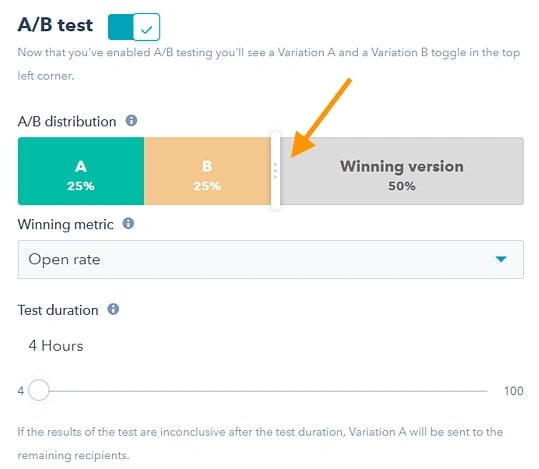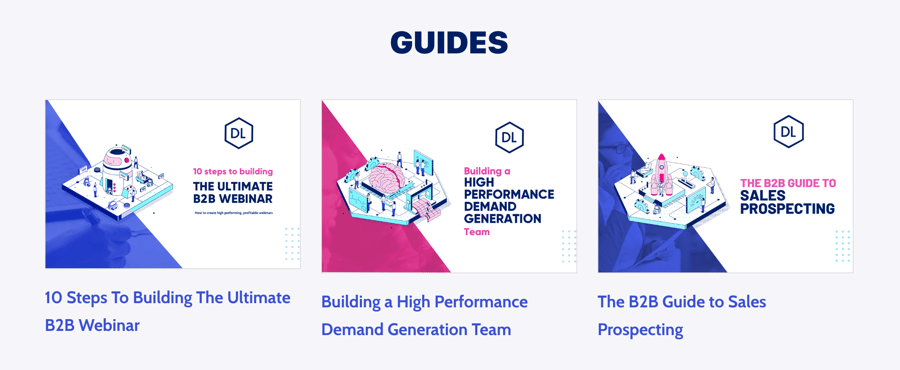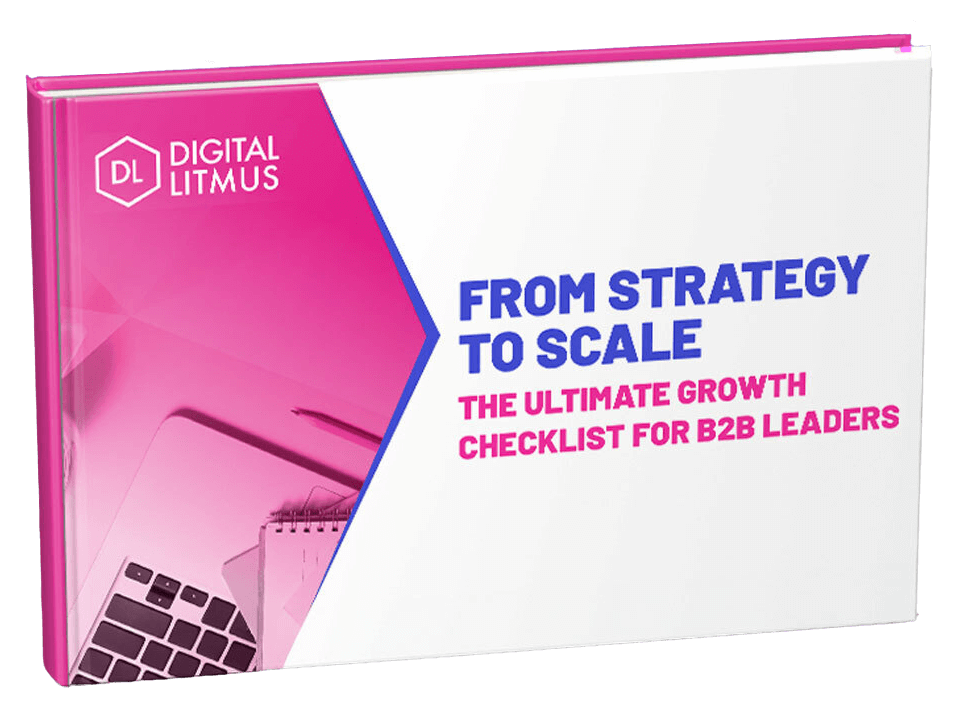Getting ahead in B2B marketing means mastering multiple lead generation strategies and tactics. With so much available, it can be tricky to know where to start.
What is Lead Generation?
Lead generation is the lifeblood of any successful business. It's the process of attracting and converting strangers and prospects into leads – potential customers who have shown interest in your company's product or service. Implementing good lead generation strategies for B2B is the cornerstone of any successful sales and marketing plan.
The B2B Buying Journey
Navigating the B2B buying journey is akin to charting a course through a maze; it's intricate, multifaceted, and involves multiple decision-makers. The B2B sales cycle often spans extended periods, demanding patience and a deep understanding of the various touch points that influence purchase decisions.
According to research by Gartner, the actual time sales teams spend engaging with B2B buyers constitutes a mere 5% of the entire buying process.
This minimal window underscores the fact that potential clients spend a considerable amount of time independently researching and weighing their options before reaching out. In such a scenario, businesses must position themselves effectively to be discoverable, relevant, and valuable during this investigative phase.
B2B buying decisions are calculated. They are rooted in a thorough analysis of value propositions, long-term ROI, and operational efficiencies. Given the intricate nature of the B2B buying process, it's paramount for businesses to refine their lead generation strategies. Such strategies should not just be about capturing attention but also nurturing interest, building trust, and demonstrating clear, tangible value to the prospective clients.
As you forge ahead in understanding and leveraging the B2B buying journey, remember that it's not about casting the widest net, but rather casting it in the right waters, ensuring every touchpoint is tailored to resonate with the unique demands and expectations of your B2B buyers.
Types of B2B Leads
Before beginning your B2B lead generation strategy, it’s important to understand the three types of leads – Leads, Marketing Qualified Leads (MQLs) and Sales Qualified Leads (SQLs).
Leads represent people who've shown preliminary interest in you. Perhaps they've engaged with a piece of your content or participated in a webinar. However, they are still at the earliest stages of their buying journey, gathering information and evaluating potential solutions without intent to purchase just yet.
MQLs are a notch above. These are leads that have interacted more deeply with your marketing campaigns and content, indicating a higher level of interest. Yet, they remain on the fence, not quite ready to take the decisive step. Their interactions suggest curiosity and consideration, but a decision is still brewing on the horizon.
SQLs are the individuals primed for the next stage. Their interactions, be it more specific queries, requests for product demos, or direct communication with sales teams, highlight a readiness to discuss purchase possibilities. In essence, they're signalling a transition from consideration to decision-making.
The overarching goal of a robust B2B lead generation strategy is to ensure a seamless flow from leads to MQLs and, eventually, SQLs. By curating targeted content, tailored interactions, and timely follow-ups, you can effectively nurture leads through this continuum, changing casual interest into actionable intent.
Want to ignite your lead generation and drive revenue growth? Explore our Demand Generation services and how we can help your business thrive!
Your A to Z of B2B Lead Generation Tactics
The backbone of your B2B lead generation strategy is the range of tactics you deploy. This guide provides an extensive list of tactics you can use to generate quality leads, depending on your unique business offering.

A/B Testing: This involves comparing two versions of a webpage, email, or other marketing material to see which performs better. For B2B lead generation, you might test different headlines, calls to action, or images to see which generates more leads.

Source: HubSpot
Account-Based Marketing (ABM): This is a targeted approach where marketing and sales teams work together to target high-value accounts. It involves creating personalised campaigns designed to engage each account, based on their specific attributes and needs.
Adverts: Paid adverts can be used across various platforms, such as search engines, social media, and digital publication sites, to increase visibility and generate leads.
Advertorials: This is a form of advertising where the content is written in the form of an article or editorial, designed to provide valuable information while subtly promoting your product or service.
Assessments: Offering free or low-cost assessments can help generate leads by providing potential customers with personalised value, such as an assessment of their website's SEO or their business's energy efficiency.
Automated Emails: These are pre-scheduled emails sent out automatically, often as part of a drip campaign. They can be used to nurture leads over time, sending targeted content based on the lead's behaviour or stage in the buying journey.

Beta Testing Invitations: Inviting potential customers to beta test a new product or feature can generate leads by offering exclusive access in exchange for contact information.
Blog Alerts: These are notifications sent to subscribers whenever a new blog post is published. They can be used to drive regular traffic to your site and keep your brand top-of-mind with potential leads.
Blogging: Regularly publishing valuable, informative content on your company's blog can help generate leads by attracting traffic to your site, improving SEO, and establishing your business as a thought leader in your industry.
Business Listings: Listing your business in online directories can improve your online visibility, boost SEO, and help attract more leads.

Case Studies: These are in-depth studies or stories about how your company helped a specific client. They provide social proof and can be a powerful tool for convincing potential leads of the value you can provide.
ChatBots – Conversational Marketing: Chatbots can be used on your website or social media platforms to engage with visitors, answer common questions, and gather contact information for lead generation.
Cold Outreach: This involves reaching out to potential leads who have not yet expressed interest in your company or product. This can be done through cold calling, cold emailing, or even cold messaging on social media.
Community Building: Creating and nurturing an online community, such as a LinkedIn group or a forum on your website, can help engage potential leads, establish your brand as a trusted resource, and create opportunities for lead generation.
Competitor Keywords: Researching the keywords that your competitors are targeting in their SEO and PPC campaigns can help you identify new opportunities for lead generation.
Content Marketing: This strategy involves creating and sharing valuable, relevant content to attract and engage a target audience. This could include blog posts, ebooks, webinars, videos, and more.
Content Syndication: This involves publishing your content on third-party websites or platforms to reach a broader audience and generate more leads.
Competition and Giveaways: Offering a chance to win a valuable prize can be a powerful way to generate leads by encouraging potential customers to provide their contact information in exchange for an entry.
CTAs (Call-to-Action): A CTA is a prompt that tells the reader what action to take next, such as "Download our free ebook" or "Contact us for a free consultation". Effective CTAs can significantly improve lead generation.
Customer Testimonials: Sharing positive feedback from satisfied customers can provide social proof and help convince potential leads of the value your business offers.

Demand Generation Campaigns: These are targeted marketing efforts to drive awareness and interest in your product or service. They often involve a mix of content marketing, email marketing, social media marketing, and more.
Direct Mail: This refers to the practice of sending physical marketing materials, such as brochures, postcards, or informational packets, directly to potential clients or businesses.
Drip Email Campaigns: These are automated sets of emails that go out based on specific timelines or user actions. They are designed to "drip" relevant information to prospects, nurturing them through the decision-making process.

Editorials: Similar to blogging, editorials offer in-depth insights on a particular topic. They establish your business as a thought leader and can draw leads when they're syndicated or featured in well-known publications.
eBooks: An eBook is a long-form piece of content that provides value to the potential lead, such as a comprehensive guide or report. They are often used as lead magnets, with the eBook offered in exchange for the prospect's contact information.
Email Marketing: This includes sending out newsletters, promotional campaigns, and personalised content to a list of email subscribers to engage potential leads and drive conversions.
Employee Advocacy: This strategy leverages your employees’ personal networks to amplify your content and reach more potential leads. It can include encouraging employees to share your content on their social media profiles.
Exit-Intent Offer: This is a pop-up offer that appears when a visitor is about to leave your website. It's designed to capture potential leads by offering them something of value, such as a discount or a free resource, in exchange for their contact information.

FAQs / Q&As: This content format answers common questions about your industry, product, or service, establishing your company as a trusted resource and helping to attract and engage potential leads.
Facebook Marketing: This includes organic posts and paid ads on Facebook, one of the most widely used social media platforms. Advanced targeting options allow you to reach your ideal audience and generate leads.
Free Consultations: Offering a free consultation is an effective lead generation strategy, especially for service-based businesses. The consultation provides value to the potential lead while allowing your business to demonstrate its expertise.
Free Tools or Services: Offering a free tool or service can attract potential leads by providing immediate value. This could be a free website audit, a keyword research tool, a template, or anything else that your target audience might find useful.
Fusion Campaigns: These involve combining multiple marketing strategies for a more comprehensive approach to lead generation. For example, a fusion campaign might include content marketing, social media promotion, and an email nurture sequence.

Gated Content: Gating some of your content behind a form can be an effective way to generate leads. Visitors are required to provide their contact information in order to access the content, which should be valuable enough to warrant the exchange.
Geo-Targeting and Local SEO: Geo-targeting involves delivering different content or advertisements to a visitor based on their geographic location. Local SEO helps optimise your online presence to attract more business from relevant local searches.
Google Marketing: This includes both organic SEO strategies and paid advertising through Google Ads. Both methods can significantly increase your visibility on Google and help attract more leads.
Growth-Driven Design: This is a web design methodology that focuses on continuous improvement and data-driven decisions. A well-designed, user-friendly website can greatly improve lead generation.
Guest Blogging: Writing guest posts for other reputable websites in your industry can help establish your business as a thought leader, drive traffic to your site, and generate leads.
Guides: Like eBooks, comprehensive guides on a specific topic provide value to potential leads and can be used as lead magnets. They are usually longer and more in-depth than blog posts or articles.

High-value Content: This is content that provides significant value to the potential lead, making them more likely to exchange their contact information to access it. This could include in-depth research reports, extensive guides, or detailed how-to articles.

Inbound Links: Also known as backlinks, these are links from other websites to your own. They can improve your SEO, drive traffic to your site, and help generate leads.
Inbound Marketing: This is a marketing approach focused on attracting customers through content and interactions that are relevant and helpful, not disruptive. With inbound marketing, potential customers find you through channels like blogs, search engines, and social media.
Industry Research Reports / White Papers: These are in-depth reports on specific topics in your industry. They can establish your business as an authority in your field and be used as lead magnets to gather contact information from potential leads.
Influencer Marketing: This strategy involves partnering with influencers in your industry to reach a broader audience. Influencers can help promote your brand, products, or services to their followers, helping you generate more leads.
Instagram Marketing: Similar to Facebook marketing, this includes organic posts and paid advertising on Instagram. It's a particularly effective platform for visual content and can be a powerful tool for lead generation, especially with younger audiences.
Interactive Content: Interactive content such as games, quizzes, calculators, etc., can engage prospects more deeply. It can help attract attention, boost brand awareness, and gather useful data for lead generation. Offering a reward for participation can increase engagement and provide an incentive for users to submit their contact information.

Joint Ventures / Co-Marketing Campaigns: These involve partnering with another business to broaden your reach. It's a way of pooling resources and leveraging complementary products or services for mutual benefit.

Keyword Research & Optimisation: This SEO strategy involves identifying the right keywords that your target audience uses when searching for products or services like yours, then optimising your content for these keywords to improve visibility.

Landing Pages: Landing pages are dedicated pages designed to convert visitors into leads. They usually offer something of value in return for the visitor's contact details and are optimised for this single conversion objective.
Lead Magnets: Lead magnets are valuable resources offered in exchange for a visitor's contact information. Examples include eBooks, white papers, free consultations, and discounts.

Lead Nurturing: This involves developing relationships with potential customers at every stage of the sales funnel. Techniques include targeted content, multi-channel nurturing, and personalisation, aimed at converting leads into customers.
LinkedIn Lead Generation Marketing: LinkedIn offers multiple methods for B2B lead generation. From publishing engaging content, using paid advertising, participating in groups, to using the advanced search feature to find prospects.
Live Chats: Live chat allows real-time communication with visitors on your website. It's a way to answer queries, offer help, and gather contact details, turning visitors into leads.
Live Events: Conferences, seminars, workshops, and other live events offer opportunities to network, showcase your expertise, and generate leads. You can collect contact details at registration, during the event, or in follow-ups.
Live Videos: Live videos on platforms like Facebook or Instagram can engage your audience in a unique, real-time way. You can host Q&As, webinars, product launches, or behind-the-scenes videos, encouraging viewers to engage and convert into leads.

Machine Learning & AI Chatbots: These automated systems can handle customer queries, book appointments, and gather information from potential leads, freeing up your time to focus on other tasks.
Micro-sites: A microsite is a small website focused on a specific campaign or product. With dedicated content and targeted SEO, it can attract qualified traffic and convert visitors into leads.
Mobile Marketing: This involves marketing on or with mobile devices. Tactics include responsive website design, mobile ads, SMS campaigns, and mobile apps, all aimed at reaching prospects where they spend a lot of their time.

Networking: Networking, both online and offline, involves building professional relationships. It's a way of meeting potential customers, referral partners, and influencers who can help grow your business.
Newsletters: Email newsletters are a way to provide value to your audience, nurture relationships, and keep your brand top of mind. Include compelling CTAs to convert subscribers into leads.

Online Advertising: Online ads can appear on search engines, social media platforms, and other websites. Tactics include pay-per-click (PPC), display ads, and retargeting campaigns, each with different ways of attracting and converting leads.
Online Courses: Offering online courses positions your business as an authority and attracts people interested in your area of expertise. They can either be a lead generation tool in themselves (free courses in exchange for contact details) or a product to generate revenue.
Organic Social Media: This involves attracting and interacting with followers on social media platforms without paid promotion. By posting engaging content, responding to comments, and participating in conversations, you can build relationships and convert followers into leads.
Outbound Marketing: This traditional form of marketing involves pushing your message out to a broad audience, often through channels like nurture mails, telemarketing, direct mail, and trade shows. It's less targeted than inbound marketing, but can still generate leads.

Paid Advertising: Paid advertising involves promoting your content, product, or service through paid channels. These could include PPC ads on search engines, social media ads, sponsored posts, or display ads on other websites.
Participation in Online Communities: By engaging in online communities relevant to your industry (like forums and social media groups), you can answer questions, offer advice, and build your reputation, attracting potential leads.
Partnerships and Affiliate Marketing: Partnering with complementary businesses or affiliates can broaden your reach. Affiliates promote your product to their audience, earning a commission for any leads or sales they generate.
Personalised Content: Personalisation involves tailoring your content to meet the specific needs of individual leads or segments of your audience. This could be based on their behaviour, demographics, or preferences. It can significantly improve engagement and conversion rates.
Personalised Video Messages: Personalised videos can help you stand out in your prospect's inbox, build a personal connection, and increase engagement. Use these for introductions, follow-ups, or thank you messages.
Podcasts: Hosting a podcast or appearing as a guest on others' podcasts can help you reach new audiences, showcase your expertise, and generate leads. Promote lead magnets during episodes and link to landing pages in your show notes.
Pop-up Forms: Pop-up forms can help capture visitor information before they leave your site. Use these forms with a compelling offer or lead magnet to increase conversions.
Product Trials or Demos: Offering free trials or demos of your product or service allows prospects to see your value before making a purchase decision. Capture contact information during sign-up to nurture these leads.
Public Relations (PR): PR activities can increase your visibility and enhance your reputation. This could involve getting featured in media outlets, releasing press statements, or winning industry awards, all of which can generate leads.
Push Notifications: Push notifications are messages that pop up on a user's device. They can be used to deliver timely, personalised messages to encourage users to return to your website or app, increasing the chance of conversion.

Question and Answer Forums: Participating in Q&A forums like Quora can showcase your expertise to a wide audience. Answer relevant questions thoroughly and link back to your site where appropriate to generate leads.

Referral Programmes: Encourage your existing customers to refer others to your business. Incentives could include discounts, free products, or other rewards. This can help you reach new, qualified leads.
Remarketing / Retargeting Campaigns: These campaigns target people who have already interacted with your business perhaps by visiting your website or clicking on a previous ad. By showing them targeted ads, you can encourage them to return and convert.
Research: Conducting and publishing original research can position you as a thought leader in your industry, attract backlinks, and generate leads. Promote your research on your website, social media, and email newsletters.

Sales Enablement: Sales enablement involves equipping your sales team with the tools, resources, and knowledge they need to sell more effectively. This can involve CRM systems, sales scripts, product knowledge, and more, helping them convert more leads into customers.
Sales Prospecting: Sales prospecting is the process of searching for potential customers, clients, or buyers in order to develop new business. This involves identifying potential leads, reaching out to them, and nurturing them through the sales pipeline.
Search Engine Marketing (SEM): SEM involves paid advertising on search engines to increase visibility. Pay-per-click (PPC) ads appear at the top of search results, helping you attract high-intent leads.
Search Engine Optimisation (SEO): SEO involves optimising your website to rank higher in organic search results. By targeting relevant keywords, improving site speed, earning quality backlinks, and more, you can attract more visitors and convert them into leads.
SMS Marketing: SMS marketing involves sending promotional campaigns or transactional messages via text message. These messages can include discounts, updates, or reminders, providing value to recipients and encouraging them to engage with your business.
Social Media Marketing: Social media marketing involves creating and sharing content on social media platforms to achieve your marketing and branding goals. This can involve posting text and image updates, videos, and other content that drives audience engagement.
Social Selling: Social selling involves using social media to find, connect with, understand, and nurture sales prospects. It's more about building relationships than pushing for a sale, but it ultimately aims to convert followers into customers.
Speaking at Events or Conferences: Speaking at industry events or conferences can establish you as a thought leader and expand your reach. Collect business cards, offer a lead magnet, or direct attendees to a landing page to generate leads.
Sponsored Events: Sponsoring an event can increase your visibility among relevant audiences. Choose events that attract your target demographic, and leverage your sponsorship to engage attendees and collect contact information.
Surveys: Surveys can provide valuable insights into your audience's needs and preferences, while also serving as a lead generation tool. In return for completing the survey, you can offer a lead magnet, discount, or entry into a competition for example.

Telemarketing / Cold Calling: Although not as popular as before due to regulations and high rejection rates, cold calling can still generate leads when done right. It involves calling potential customers, introducing your product or service, and gauging their interest.
Testimonials: Customer testimonials serve as social proof, showing prospects that others have successfully used your product or service. Display these on your website, social media, and other marketing materials to build trust and convert more leads.
Thought-Leadership: Thought leadership involves establishing yourself as an expert in your field through content like blogs, videos, research reports, etc., By offering valuable insights, you can build trust, attract more prospects, and convert them into leads.
TikTok Marketing: With its rapidly growing user base, TikTok offers unique marketing opportunities. Create engaging video content, participate in trends, use relevant hashtags, and collaborate with influencers to attract followers and generate leads.
Trade Shows & Exhibitions: These provide an opportunity to showcase your products or services to a targeted audience. They're also an excellent venue to network with industry professionals, generate brand awareness, and collect business contact information for follow-ups.
Traditional Marketing: This includes methods like print ads, billboards, TV and radio commercials, direct mail, and telemarketing. Despite the rise of digital marketing, these methods can still be effective in certain industries and for certain demographics.
Twitter (X) Marketing: Utilise Twitter's unique platform to share updates, engage with followers, and participate in trending discussions. Twitter's advanced search functions and use of hashtags also make it a useful platform for lead generation.

User-Generated Content (UGC): Encourage your users to create content related to your business. This could be through contests, hashtags, or simply by providing an excellent product or service. User-generated content provides social proof and can generate good leads.

Video Marketing: Videos can convey complex information in a digestible format. They can be educational, entertaining, or inspirational. Utilise platforms like YouTube, or embed videos on your website or in social media posts to engage your audience and generate leads.
Voice Search Optimisation: With the increasing use of digital assistants like Siri and Alexa, optimising for voice search is becoming crucial. This involves using conversational keywords, optimising for local SEO, and ensuring your website is mobile-friendly.

Web-based Training: Offering web-based training or e-learning courses can provide value to your audience and generate leads. Promote these courses on your website and social media, and require users to provide their contact information to access the course.
Webinars: Webinars allow you to provide in-depth information on a topic, demonstrating your expertise and providing value to attendees. Collect registration information for lead generation and follow up with attendees after the event.
Websites / UX Design: Your website is often the first interaction a potential lead will have with your business. A well-designed, user-friendly website that provides valuable content can attract and convert leads.
WhatsApp Marketing: With its huge global user base, WhatsApp can be a powerful marketing tool. Use it to send updates and promotions, provide customer service, and even take orders.
White Label Content: This involves producing content to be rebranded and used by another company. It's an excellent way to expand your reach and generate leads. Provide high-quality, valuable content to ensure your white label partners are happy to work with you.
Word of Mouth: Encourage satisfied customers to share their positive experiences with others. Word of mouth can be one of the most effective ways to generate leads as recommendations from friends or colleagues are often viewed as more trustworthy.

YouTube Marketing: As the second largest search engine, YouTube can be a powerful platform for lead generation. Create and share valuable video content, optimise your videos for SEO, and include clear calls to action to generate leads.
Customising Your B2B Lead Generation Strategy
-min.png?width=650&height=366&name=iStock-1178481132%20(1)-min.png)
In attracting the right leads, a one-size-fits-all strategy rarely exists or is successful. What works for one business may not necessarily work for another. The complexity and diversity of the B2B landscape demand strategies that are not only nuanced but also aligned with the inherent nature of the business in question. SaaS and enterprise businesses, for instance, exhibit distinctly different lead generation characteristics and challenges.
B2B SaaS Lead Generation
SaaS businesses often thrive on a model of scalability and self-service. Their products or services are designed for quick adoption, typically with a shorter sales cycle. This rapid pace necessitates lead generation tactics that are agile, engaging, and often automated.
Think along the lines of free trials, online demos, or interactive product tours. Given the self-serve nature, B2B SaaS lead generation strategies aim to swiftly move potential customers from awareness to consideration, often using content marketing, PPC campaigns, and retargeting to keep the product top-of-mind.
B2B Enterprise Lead Generation
Enterprises, with their vast and intricate operational matrices, possess a sales cycle that is inherently longer and more intricate. The decision-making process often involves multiple stakeholders, necessitating strategies that cater to varied audiences. This can include white papers that address industry-specific challenges, bespoke webinars, or even one-on-one consultations.
The goal here is to nurture relationships, establish trust, and highlight long-term value. In essence, while a SaaS company might look to convert leads swiftly, an enterprise would focus on gradually establishing authority and fostering deep-rooted connections.
While overarching principles of trust, value, and engagement remain consistent, the tactics and tempo of lead generation for SaaS and enterprise vary significantly. Crafting strategies that resonate with your business model, therefore, becomes not just desirable, but essential.
Understand Your Target Audience
The foundation of a robust lead generation strategy lies in a deeply rooted understanding of your target audience. It's not just about knowing who they are, but delving into the intricacies of their behaviour, preferences, and challenges. Only then can you create a laser-focused strategy with marketing messages that resonate effectively.
Building Buyer Personas: Buyer personas are semi-fictional representations of your ideal customers. They encapsulate various aspects of your target audience, from basic demographics (age, job title, industry) to more detailed psychographics (habits, preferences). Creating these personas involves:
Defining Ideal Customer Profiles (ICPs): While personas focus on individuals, ICPs focus on companies. They define the types of businesses that are the best fit for your product or service.
With personas and ICPs in hand, it's crucial to comprehend the specific needs and challenges these entities face. Are they looking for cost-effective solutions, or are they more interested in premium, high-tech offerings? Do they value customer support above all else, or are they more self-sufficient?
Define Your Goals
What do you hope to achieve with your lead generation efforts? Are you looking to increase overall leads, or are you focusing on a specific segment? Do you want to increase the quality of your leads? Your goals will guide your strategy and help you measure success.
Choose the Right Tactics
Now that you have a clear understanding of your audience and your goals, you can select the most appropriate tactics from the plethora of B2B lead generation strategies we've discussed.
Test, Measure, and Adjust
Once you've implemented your chosen tactics, it's important to continually test and measure the results. Use tools like Google Analytics, a CRM system like HubSpot, and other marketing software to track your success. Don't be afraid to adjust your strategy if something isn't working or if you find a tactic that works exceptionally well.
Combine Multiple Tactics
Don't limit yourself to just one tactic. The best lead generation strategies often involve a combination of tactics, used together in an integrated way. For example, you might use content marketing to draw in organic traffic, email marketing to nurture those leads, and social media marketing to engage and convert them.
Create a Lead Nurturing Process
Remember that lead generation is only the first step in the sales process. Once you've attracted a lead, you need to nurture that relationship until they're ready to make a decision or purchase. Your B2B lead nurturing process might involve email marketing, retargeting ads, or personalised content.
Keep Up with Changes
New platforms emerge, user behaviour changes, and tactics that once worked may no longer be effective. Stay up-to-date with the latest trends and be willing to adapt your strategy as needed.
By customising your lead generation strategy to your unique business needs and constantly measuring and adjusting your approach, you can maximise your success and achieve your lead generation goals.
Elevate Your B2B Lead Generation Game
In the world of B2B, lead generation can seem complex, but armed with this guide, you'll be able to navigate the landscape with confidence. The right mix of tactics can help attract high-quality leads, driving growth and solidifying your place in the market.

Are you a B2B company looking to accelerate growth?
Our connected sales, marketing, and HubSpot agency services might be just the ticket. Get in touch for your free growth assessment to find out how you can accelerate business growth today.
-min.png)

.jpg)
.jpg)

.jpg)